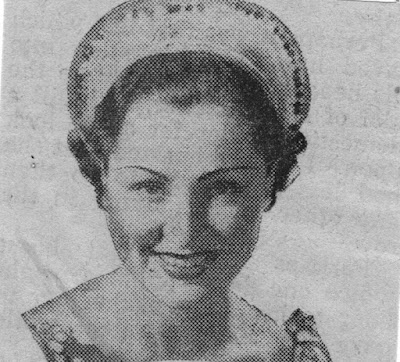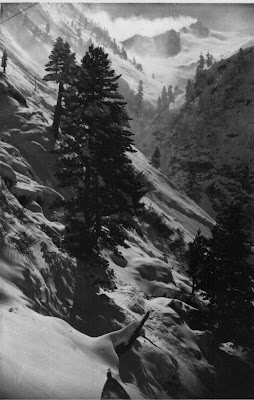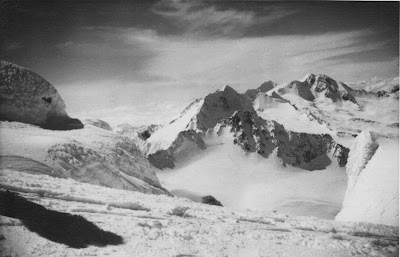Most of what I
gathered and collated, after fulfilling its first function as source material
for my British Musical Theatre and Encyclopaedia of the Musical Theatre,
found its way, with the rest of my British Musical Theatre Collection, to the
great collection of theatricalia at Harvard University; but some of it – for
various reasons -- didn’t. And that ‘some’ -- all sorts of bits and pieces --
has just been sitting here … until now.
This morning I came
across some ‘stuff’. I remember buying it. It was ‘a lot’. A chorus girl’s
scrapbook, with all sorts of bits and pieces bundled in. I grabbed it because
it was interleaved with photographs. Real, first-class production photos of Daly’s and
Gaiety Theatre musicals of the 1930s, some nowhere else reproduced. Well, they
have been now, because they have been largely featured in my books, and have
since headed with all the other goodies to Harvard. But there are still the
bits and pieces…
The chorus girl
was a soubrette-dancer known as ‘Eileen Merry’, born in Bromley 13 March 1907, as
Phyllis Eileen Wilks. This 1920 pupils’ concert programme includes Phyllis
Wilks in a Russian dance.
I guess,
therefore, that she wasn’t the ‘Eileen Merry’ at the Hull Tivoli in 1919 playing
alongside one comical Charles Chaplin. Maybe the one in Scotland, in concert
party and panto in 1922? But the scrapbook starts at Easter 1927 when Eileen is
singing ‘I can’t get over a boy like you’ and ‘My cutie’s due’ with ‘Murray
Ashford’s Entertainers’ at Sandown Pier, Isle of Wight, and holiday spots beyond, as well as on
2LO radio, between Mrs Cranswick’s talk on fruit bottling and Yid Nesbitt and
his brother Harry with comedy and ukelele.
In 1929, she moved
into the theatre, joining the chorus of Good
News on tour, before advancing to the West End in the new Darling, I Love You at the Gaiety, then
the Oscar Asche production of El Dorado
at Daly’s, Blue Roses, The Millionaire Kid, revivals of Miss Hook
of Holland, The Duchess of Danzig and San Toy, Laddie Cliff's Rhyme and Rhythm at the Winter Garden, and the
new musicals Jill Darling, Seeing Stars and Swing Along … sorry, no pictures. For
those you have to look in my books or go to Harvard.
In 1937, Eileen
quit the West End chorus line and went back to her origins. As a solo act in
the seaside concert party. And there she met comedian [Harold] Cedric Miller.
Apparently (but only apparently) a widower. In spite of an existing Mrs Laura Miller (née Townsend), and a daughter Yvonne Joy (b 13 November 1916; d Eastbourne 1997), they were married later that year.
Cedric had been in
the business for 25 years. He was the son of a Putney jewellery wholesaler,
born in 1892, and had been educated at Westminster School. He started out articled to a chartered accountant, but Cedric wanted
the stage, and my bundle has a contract from Robert Courtneidge hiring him, age
21, to play the bit part of Mr Pringle in the touring production of his
Shaftesbury Theatre success, The Pearl
Girl.
But he, too, did
not or could not stick with the stage, and he went seaside with Muriel George’s Bunch of Keys
party, with Ernest Crampton’s Clowns and
Curios, with Bert Aza’s revusical Crazy
Town, and touring with Archie
Pitt’s company of the Fields Family, star Gracie, as a supporting comic in By Request.
Thereafter, Cedric
and Eileen worked largely together, and in concert parties – The Seamews, The
Hey Presto! Follies, in Flotsam’s Follies with Hilliam, at Ramsgate, Skegness
and all the old familiar places – and in pantomime, and as the concert party of
old faded away they moved into summer season at Butlin’s in Filey …
During the war,
they joined the NAAFI ..
Cedric died 26
October 1963 at their home at 3 Putney Hill. Eileen lived on another fifteen
years and died, at the same address, 20 December 1978. And I guess it was not long after that that
the young Kurt Gänzl went to a junk fair …
PS this scrapbook has now joined the rest of my stuff at Harvard. Knock three times, and ask for Andrea.












































